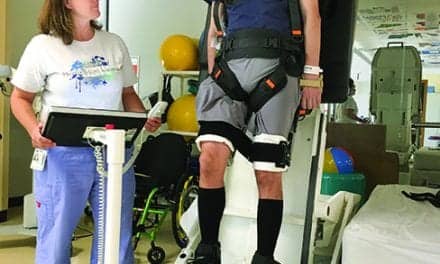Children with spinal muscular atrophy (SMA) carry specific gene defects which cause progressive muscle wasting and weakness. Left untreated, the condition usually results in early death. Approval was recently granted for a gene replacement therapy that enables the maintenance of muscle function. However, due to the treatment’s relative novelty, data on safety and efficacy remain limited.
A team from Charité – Universitätsmedizin Berlin recently conducted the first multicenter clinical study to evaluate data on the side effects associated with this new gene replacement therapy. Their study showed that treatment resulted in significant improvement in muscle function, particularly in children under 2 years of age. The researchers’ findings have been published in The Lancet Child & Adolescent Health.
In Europe, the incidence of SMA is about one in 10,000 live births. The disorder results from a genetic defect which causes a deficiency of the survival motor neuron’(SMN) protein in specific nerve cells in the spinal cord. Defective nerve cells are unable to transmit nerve impulses they receive from the brain to the muscles. The result is progressive muscle weakness and a lack of motor development, which also affects the muscles used for breathing. Most children with SMA are affected by the severest form of the disease which, without treatment, will result in death within the first two years of life.
“Now, however, there is new hope. Since 2020, children in European Union countries have been able to receive a gene replacement therapy which restores their ability to produce the functional SMN protein,” explains Prof. Dr. Angela M. Kaindl, Head of the Department of Pediatric Neurology and Director of Charité’s Center for Chronically Sick Children.
Due to the severity of the disease involved, treatment with the novel gene therapy medication onasemnogene abeparvoven (marketed as Zolgensma) was approved on the basis of limited data.
“During the first year, pediatric neurologists therefore had to proceed with caution, carefully gathering data on both the effects and side effects of this new treatment,” explains Prof. Kaindl, who led the study into the efficacy and side effects of this new gene replacement therapy in a large group of children.
Large Observational Study
As part of this large observational study, the research team recruited a total of 76 children aged between 6 months and nearly 5 years from 18 participating treatment centers in Germany and Austria. Following their treatment with the gene replacement therapy between September 2019 and November 2020, the children were monitored for a period of 6 months. Participants included children for whom only a limited amount of data are available, namely children who had received nusinersen (the medication previously used to treat SMA) and children aged over 24 months and weighing up to 15 kilograms.
The research team used standardized tests to evaluate the children’s motor function both before and after treatment. They then analyzed to what extent these data correlated with age, sex, type of disease and prior therapy.
“Gene replacement therapy improved significantly the children’s muscle strength, irrespective of whether they had received prior treatment with nusinersen. They were able to reach new developmental milestones and showed improvements in crawling, sitting and standing,” says Prof. Kaindl. She adds: “This positive effect was particularly noticeable in children under 24 months of age; but even older children, who are usually more severely affected by SMA, were seen to benefit from treatment.”
Common side effects recorded included fever, vomiting, a low blood platelet count and abnormal liver function.
“We paid particular attention to potential liver function abnormalities, which occurred in six children. Most cases required prolonged corticosteroid therapy to reduce liver inflammation beyond the recommended treatment duration of eight weeks. However, adverse effects are easily managed with close clinical monitoring in a specialist center,” explains Prof. Kaindl.
Summarizing the results of the research, she adds: “This new gene replacement therapy offers an effective and safe alternative to nusinersen (the treatment previously used for SMA), particularly if used early. The recent introduction of an SMA screening test for use in newborn infants will help make this possible. Our data also enabled us to recommend a follow-up treatment regimen to facilitate the management of potential treatment side effects.”
In order to evaluate the new gene replacement therapy’s long-term effects, the researchers are planning to extend their observational study to collect longer term follow-up data on the same group of children.
[Source(s): Charité – Universitätsmedizin Berlin, EurekAlert]





